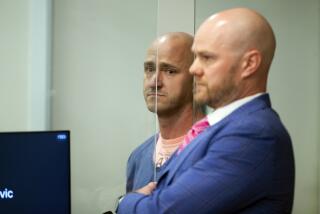Pilot Shut Down Wrong Engine in British Crash, Probers Find
- Share via
LONDON — Britain’s Air Accidents Investigation Branch confirmed Monday that the pilot of an ill-fated British Midland Airways Boeing 737 had shut down the wrong engine of his crippled airplane before it crashed last Jan. 8, killing 47 passengers.
The agency in a bulletin on the crash appeared to discount the possibility that faulty instruments or wiring had led to the error; however, it did not offer any specific explanation for the pilot’s action.
The accident caused aviation authorities here and in the United States to order extra checks on similar planes.
Immediately after the January crash, officials said it appeared that both engines on the 12-week-old aircraft had failed--against odds of several million to one--and pilot Kevin Hunt was hailed as a hero for averting an even worse tragedy. The pilots and 77 others aboard the plane survived the crash.
The report confirmed that Hunt had shut down his apparently good right engine after a turbine blade broke in the left one, setting it on fire.
“The No. 2 (right) engine has been fully stripped and shows no evidence of pre-crash fire or failure,” according to the accident investigation unit, a branch of Britain’s Department of Transport.
“The No. 1 (left) engine showed evidence of fire damage . . . (and) fragments of engine fan blades from No. 1 engine were found under the approach path, up to 3 1/2 kilometers (just over two miles) east of the crash site,” the bulletin added.
Reuters news agency quoted Hunt in his first public comment on the crash as saying in a written statement, “Both the first officer and I agreed that the starboard (right) engine was causing us the problem.”
Hunt, who was injured, added, “We were desperately hoping the port (left) engine would last long enough for us to reach the runway.”
According to the investigation, the British Midland flight experienced a “moderate to severe” engine vibration, a burning smell and smoke 13 minutes into its shuttle flight from London to Belfast. “The two pilots then diagnosed the symptoms . . . as indicating a problem in the right engine,” even though the flight recorder later proved that cockpit instruments had shown correctly that it was the left engine that was in trouble.
No Further Problem
Commander Hunt ordered the right engine throttled down, and the vibration appeared to ease. After diverting toward an airport in the British Midlands, the crew shut down the right engine entirely and experienced no further problem until seconds before touching down.
Then the left engine suddenly lost power and began to vibrate violently. Hunt ordered his co-pilot to try to restart the right engine, but there was no time. Less than one minute after they realized that the left engine was in trouble, the plane crashed.
More to Read
Sign up for Essential California
The most important California stories and recommendations in your inbox every morning.
You may occasionally receive promotional content from the Los Angeles Times.













